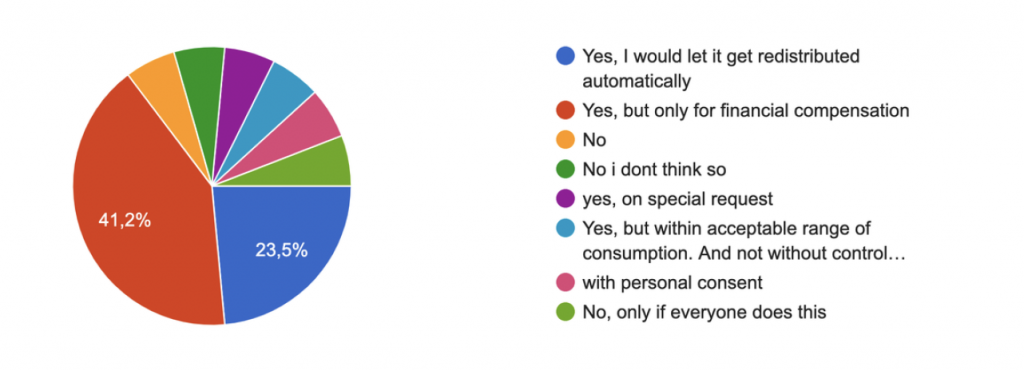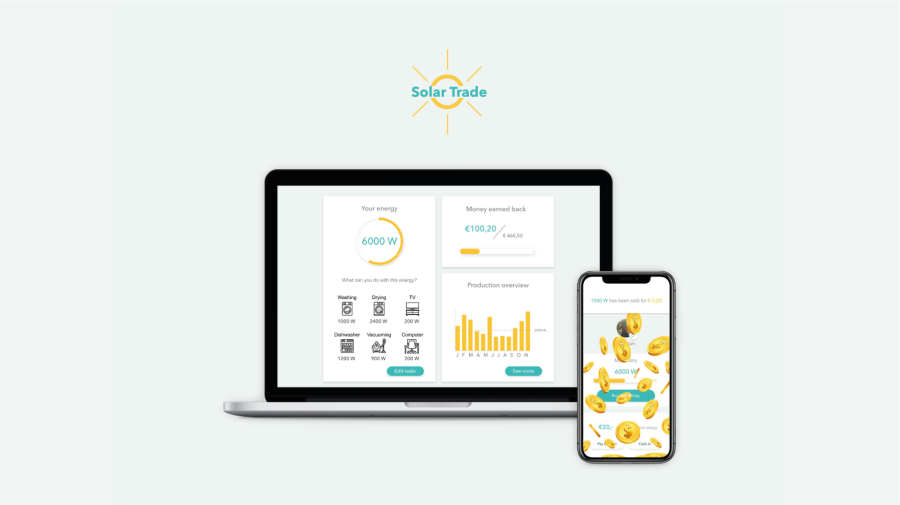Student: Tara van Kleef
Study: Minor User Experience Design
In May 2020 Students of the minor User Experience Design were involved in a Circulate student project. They were asked to engage a fictional community in balancing energy usage and production by visualising the (private and collective) usage and availability of energy.
In creating this visualisation (in the shape of an interface or dashboard) the students were asked to specifically consider the dilemma of privacy vs. transparency: which information should be collectively shared and which should be kept to individual families? What are the implications of the design decisions made? What are the ethical considerations made?
The product
Solar Trade is Tara van Kleef’s answer to the design brief: an energy dashboard in the home in combination with an energy sharing marketplace aimed at young adults.
Key Findings
Solar Trade’s target group isn’t affluent, they are privacy focused and the environment is not a motivational factor for most. The platform was therefore aimed at economical motivation, with privacy being an important focus.

Investing in solar panels is expensive, especially for young adults. The investment usually pays itself back within 10 years. An energy marketplace can speed up this process by users being able to sell their energy.
In addition, the energy dashboard (displayed within the users home) promotes privacy and motivates the user to reduce their energy usage.

Trade-offs and dilemmas
Privacy vs. Transparency
Through interviews, the designer found that her target group of young adults are individualistic and privacy-minded. They want only to see their own production and usage and feel a sense of ownership over the energy they produced. The designer therefore chose to create a privately owned energy dashboard in combination with a marketplace app in which the users themselves can determine how much energy they want to sell.
Quantified vs. Qualified
Within a particular community many value flows and transactions can exist, some are based on motivations such as altruism, idealism and social responsibilities whilst others are formalised and quantified. Within Solar Trade’s target group the designer found that users were more motivated by quantified (tokenised) transactions rather than idealistic motivations such as the environment. She therefore chose to create a marketplace in which users could buy and sell energy.
Human vs. Algorithmic & Planned economy vs. Free market
Whilst creating the marketplace application the designer asked herself who chooses the prices for energy: should she set a standard price for energy should users be able to decide prices for themselves. A decision that goes hand in hand with the dilemma of Human vs. Algorithmic governance: which parts of the application should be decided by an algorithm (allowing for fast decision making) and which parts should be made by humans (allowing for democratic debate and flexibility). The designer eventually chose to promote a free market system and human governance to motivate users to buy and sell energy.
Design decisions
Investment earned back
Since the target audience is motivated by quantified (tokenised) transactions rather than idealistic motivations, the designer chose to implement a section in the users private dashboard showing how much they earned back from their investment. The section shows progress in two ways: numerical values and a progress bar.
Privacy settings
The mobile application features a control panel in which users can choose their own name and profile picture, as the main target group is privacy-minded.
Animations
In order to further motivate users to sell their leftover energy on the marketplace, the designer made use of motivational animations. To celebrate a sale, a money rain animation will play to end the experience with delight.
The final product
A full design rationale of the product can be found here:
